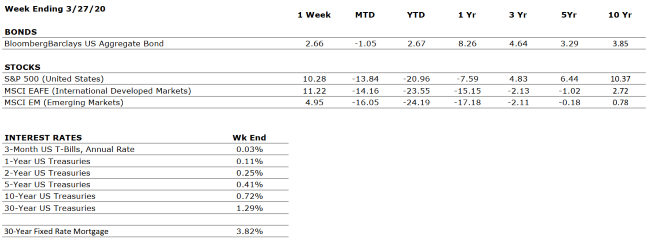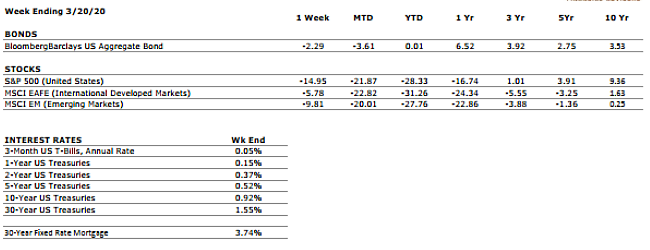by Connor Darrell CFA, Assistant Vice President – Head of Investments
As the threat of COVID-19, the disease caused by the novel coronavirus, has continued to escalate over the past few weeks, fear and panic have gripped financial markets and society at large. The risks emanating from the fallout of the virus’ spread have wreaked havoc on financial markets and pushed equities well into bear market territory. Since it first became apparent that containment of the virus was no longer reasonably achievable, we have spent a great deal of time trying to assess the long-term economic risks that the virus poses. The unpredictability and fluidity of the situation makes any economic forecasting extremely difficult, and that is part of the reason that markets have reacted the way they have. But in times of stress, it’s imperative that investors maintain perspective. With this edition of The Weekly Commentary, we aim to summarize some of the key facts that we have learned over the past few weeks, share our latest assessment on the economy and markets, and offer perspective on how to look forward rather than backward.
COVID-19: What Do We Know?
As the scientific community has scrambled to ramp up research efforts and gain a better understanding of this novel disease, there has been no shortage of information being shared via news publications, scientific journals, and word of mouth. Despite the amount of resources being dedicated to research, the fact of the matter is that these analyses take time, and much is still unknown about how the virus operates. We do know that based on the data it has available, the World Health Organization recently made the decision to officially declare the current situation a global pandemic; a decision that many believe should have been made much earlier. We also know that scientists are finally beginning to get a handle on exactly how the disease spreads and how it compares to prior pandemic diseases.
A comparison to
prior pandemic diseases is one of the simplest ways to assess the potential
impacts of COVID-19, but it is important to note that each pandemic is unique
by nature. Coronavirus pandemics are a relatively new phenomenon (many other
pandemics throughout history have been flu viruses), so there are fewer points
of reference for the current situation, but when compared to the virus that
caused the SARS outbreak in 2002, the strain of coronavirus causing COVID-19
appears to be less lethal and have a lower rate of transmission. However, this
disease has been much more difficult to contain because patients are contagious
for a much longer period of time and often while exhibiting no symptoms at all.
As a result, modest containment measures that respond only to confirmed cases
where patients are exhibiting symptoms have been rendered ineffective.
The general
expectation among experts is that the virus will continue to spread through
community transmission, eventually reaching peak levels at some point over the
next 6-8 weeks. Faced with that reality, we anticipate widespread school
closures and recommended telecommuting by employers. We also expect economic
stimulus in the form of both monetary and fiscal policy initiatives aimed at
providing stability to markets and assurances for impacted families and
businesses. President Trump addressed the nation on Wednesday evening, offering
some preliminary measures that did not appear to appease markets, leading to
further large-scale losses during Thursday’s trading session. However, we
anticipate additional measures will be discussed and eventually passed through
Congress.
The Current State of Markets and the Economy
The swift and violent nature with which markets have responded to the threat of COVID-19 has been a result of a variety of factors. First, market sentiment was extremely positive coming into the year as a result of improving economic fundamentals and anticipation for accelerating earnings growth. Those lofty expectations led to lofty asset prices, which meant stocks had further to fall once the full threat of COVID-19 became appreciated. Secondly, the exogenous shock to the economy that COVID-19 represents is not something that can be easily addressed through traditional economic policy initiatives. Lower interest rates and tax relief will not stop the spread of the virus, adding to the uncertainty of the situation. Lastly, the immediate reduction in demand for oil resulting from the spread of COVID-19 has coincided with a political struggle between Russia and Saudi Arabia with respect to oil production capacity. Both nations are looking to exert pressure on other oil producers in order to gain market share, and this has led to a sharp decline in the price of oil. Oil’s decline has resulted in a rush of “risk-off” sentiment in corporate credit markets, of which energy producing companies make up a large share of borrowers. It’s important to note however, that lower oil prices will be a net positive for consumers once the spread of the virus subsides and consumer behavior normalizes.
As might be
inferred from reading the paragraph above, the variety of threats that have
surfaced in recent weeks represent a material risk to economic activity over
the next several months. It is not out of the realm of possibility that the global
economy falls into a technical recession (defined by two consecutive quarters
of negative economic growth rates), but we believe there are a number of
reasons for investors to remain optimistic about the ensuing recovery.
First, we know
that the U.S. economy is addressing these threats from a position of strength.
As a result of significant reforms enacted following the global financial
crisis, U.S. banks are extremely well capitalized and are well positioned to
deal with potential stress. Secondly, the risks that the economy faces are
quite different from those of a “traditional” recession. Typical recessions
result from internal shocks such as an asset bubble, monetary policy missteps,
or weaknesses in the financial system. These types of recessions often lead to
structural issues within labor markets that force the reallocation of labor and
resources to different industries. For example, the housing crash and financial
meltdown in 2008 led to a substantial reallocation of resources away from construction
and real estate, and many jobs that were lost were permanently eliminated. By
contrast, as the economy emerges from the impacts of COVID-19, workers are more
likely to be able to simply return to their previous jobs and resume economic
output. At the very least, the friction we have seen in prior recessions which
has slowed the recovery in labor markets is likely to be significantly less
prevalent. As such, we believe it is reasonable to anticipate that confidence
would rebound more quickly than analyses of prior periods of economic stress
might suggest.
Lastly, given
the market’s disappointment in the President’s remarks on Wednesday, we
anticipate that the federal government will continue to look at more aggressive
policy action moving forward. In fact, we have already seen progress on this
front, as the House of Representatives passed a bipartisan legislative package
over the weekend which the Senate is expected to vote on this week. This
package will be aimed at providing assistance to impacted families and
businesses, and there are already discussions in place for further measures to
be taken as needed. We believe that the timing of additional fiscal responses
will be important, with measures focused on boosting demand being enacted after
the disease reaches its inflection point in order to maximize their impact.
Looking Forward
At this point in time, equity markets are about 28% off of their previous highs. Given our assessment of the economic picture and the prospects for a relatively swift recovery (though the timing remains uncertain), we believe that the vulnerability of the human psyche has exacerbated market declines, and that market prices have begun to separate from what might be considered rational. Furthermore, the size of the selloff in equities has likely led to significant portfolio drift in many instances. And while we would never seek to “call the bottom” (and consistently advise our clients against attempting to do so), we have long preached that disciplined investors should seek to rebalance to long-term target allocations whenever portfolio drift becomes significant. This principle is true in both up and down markets. As such, rather than falling victim to the fear and panic which have gripped markets and society, we believe investors should begin looking for opportunities to rebalance portfolios. While it can often be emotionally difficult, this process involves purchasing assets such as equities which have significantly depreciated over the past few weeks. Rebalancing does not necessarily need to be achieved in one trade, but it is an important tool for keeping portfolios aligned with what is required to achieve long-term goals.
The rapidity of
the market’s reaction to the spread of COVID-19 has been historic. But as
discussed above, our assessment at this point in time is that panic has played
a significant role in what we have seen from markets, especially over the past
week. When markets are being driven by panic, a disciplined and objective
approach to portfolio management is of the utmost importance. As such, it is
important for us to focus on what we can control rather than what we cannot.
This does not only include details related to our investment portfolios
(maintaining an asset allocation that is appropriately aligned with our
investment goals), but in the wake of the mounting threat we face as a society,
it also includes simple things like proper hand hygiene, taking necessary
precautions as recommended by authorities, and working together to protect ourselves
and our communities. We do not know when the market will find its bottom or how
long it will take for our lives to return to normal, but we do know (because we
have seen it in China and in South Korea) that we will emerge on the other side.


